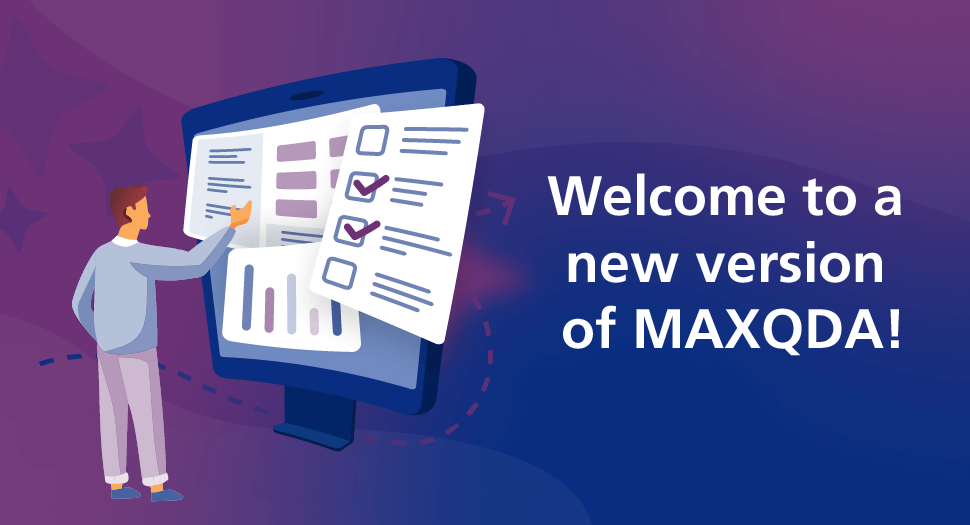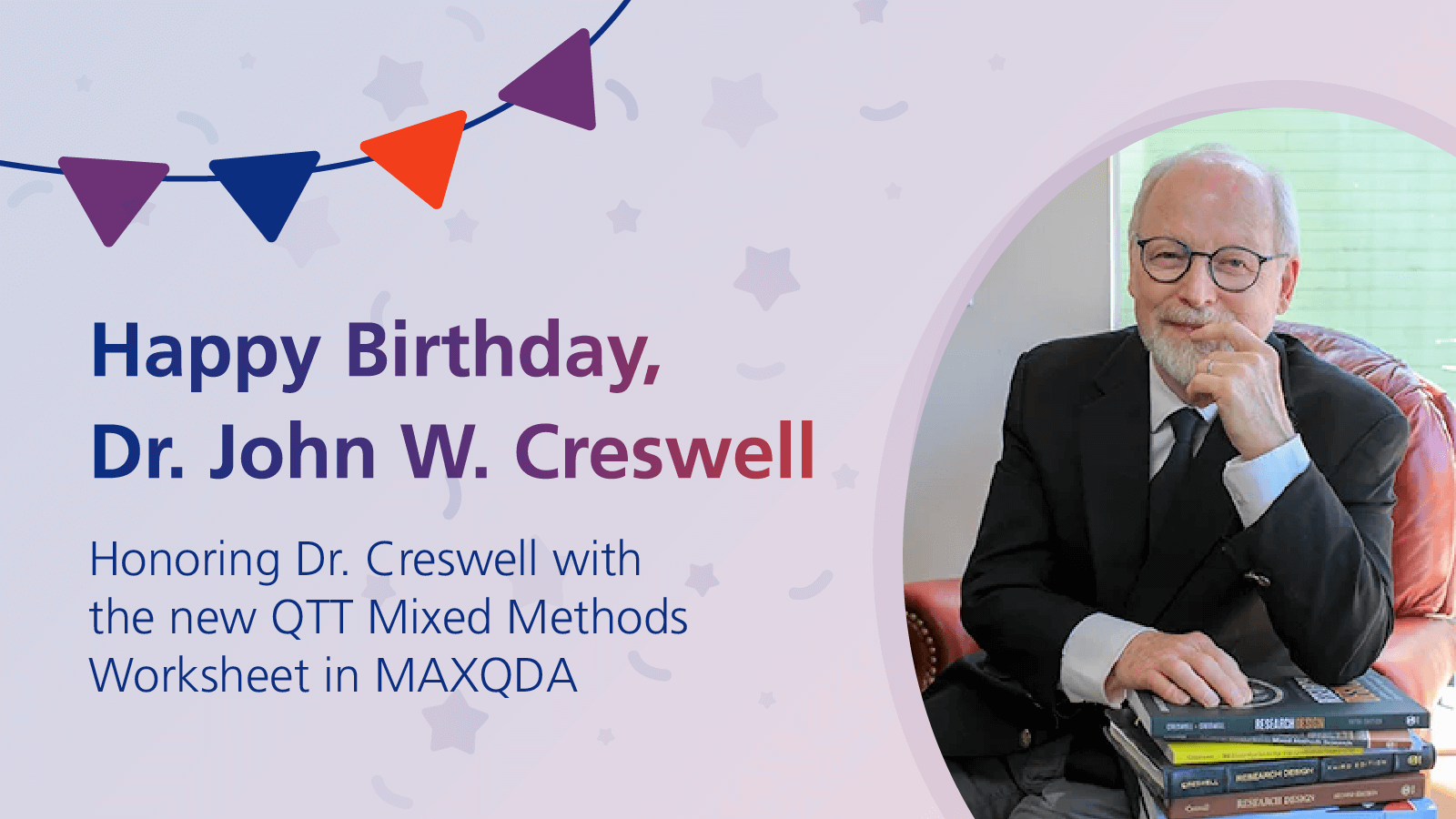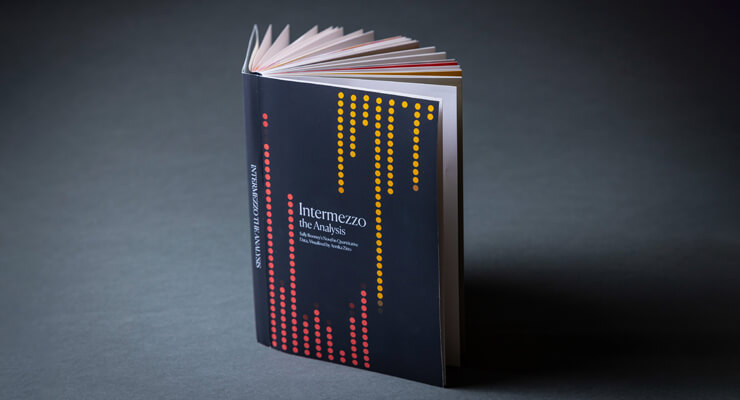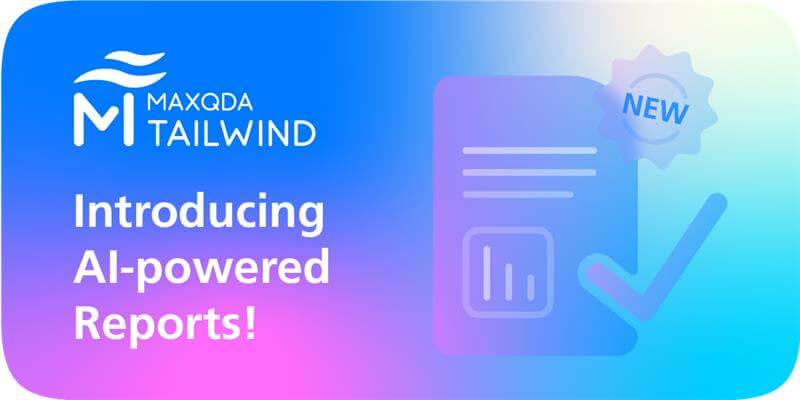Guest Post by Melinda González.
In my first Fieldwork Diary Entry, I began by summarizing my project, which is situated across three field sites – Puerto Rico, New York, and digital media (Twitter, Facebook, and Instagram) in the aftermath of Hurricane Maria hitting Puerto Rico on September 2017.
This entry is going to focus on what I do with all of the fieldwork data that I collect after attending an event called The 7th Annual Black Comic Book Festival at the Schomburg in Harlem, New York City. My data collection and analysis is being conducted using MAXQDA 2018.2.
Melinda’s First Fieldwork Diary Entry
Collecting Fieldnotes at the 7th Annual Black Comic Book Festival
I was informed that there would be a panel at the festival on Hurricane Maria by Brooklyn-based painter and poet, Sarah Serrano. Three important figures in Puerto Rican literature were scheduled to attend: Esmeralda Santiago, the author of ‘When I was a Puerto Rican‘, Crystal Velasquez, author ofHunters of Chaos, and Edgardo Miranda-Rodriguez, creator of the graphic novel ‘La Borinqueña‘ and curator of the comic book collection ‘Ricanstruction: Reminiscing and Rebuilding Puerto Rico‘.
Sarah Serrano and I met at the Schomburg on Friday, January 18, 2019 just in time to attend a panel discussion entitled “AfroPuertorriqueños: Cultural & Social Activism in Comics”. The name of the panel, however, had been altered, to reflect a focus on the development of ‘Ricanstruction: Reminiscing and Rebuilding Puerto Rico’, and how Miranda-Rodriguez and writers intended on using the revenue from the comic book to support recovery efforts in Puerto Rico.
They had created La Borinqueña Grants Program, which “will award a $10,000 grant to each of nine different grass roots organizations in Puerto Rico that have been working heroically in the recovery efforts and rebuilding of the island via programs for youth, women, community members, and the environment.”
During the panel, I took notes in my field notebook and took photos. These would then be transferred into MAXQDA when I got home.
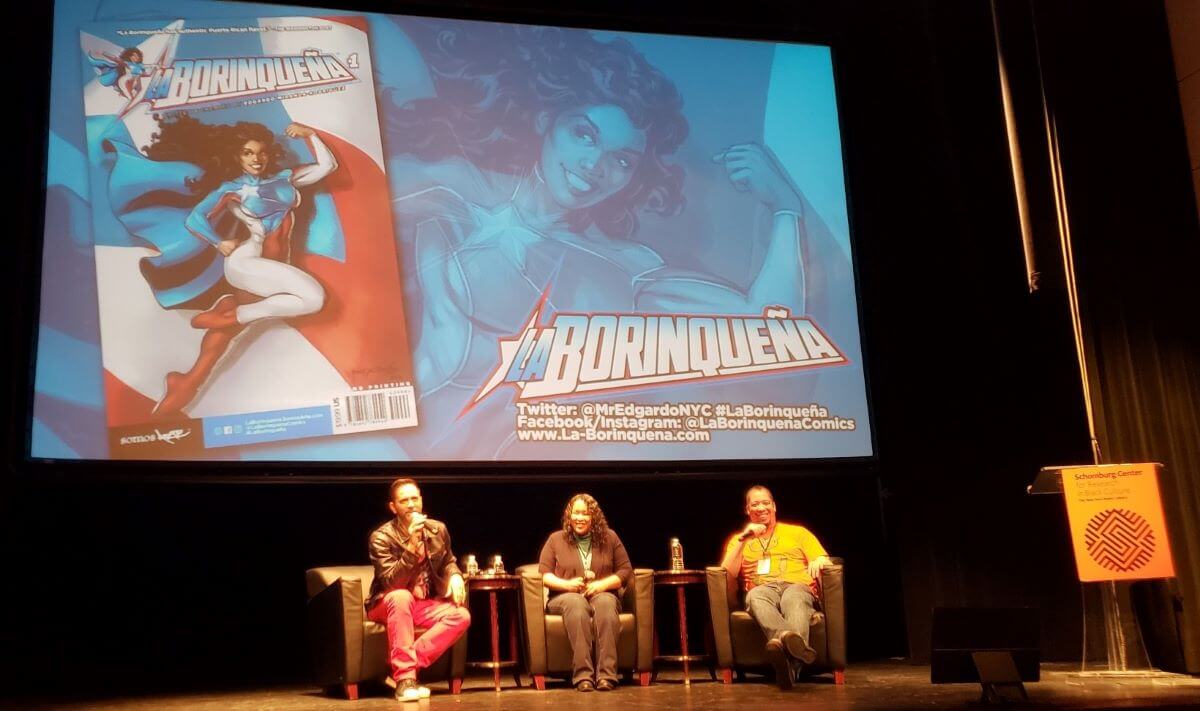
Panel at the Schomburg in New York, New York, January 2019 (Photo taken by Melinda González)
Transferring Fieldnotes to MAXQDA
The first thing I did was open MAXQDA’s Logbook function and write down my fieldnotes. Then, I uploaded the photos (as shown in the screenshot below). Photos were very important to this particular trip because the focus was on art and activism and the use of images to bring awareness to the continued challenges after Hurricane Maria as well as the important motives being addressed in the visual representation of these specific struggles.
Organizing Fieldwork Data with MAXQDA 2018
Emoticoding
Once the photos were uploaded, then I began to code them. I begin a lot of my coding by using MAXQDA’s emoticode® and color coding (highlighting) features. During the early data analysis stages, I realized that I was creating way too many codes, so using emoticodes® allows me to more easily conduct early analysis without being overwhelmed by the sheer amount of the data.
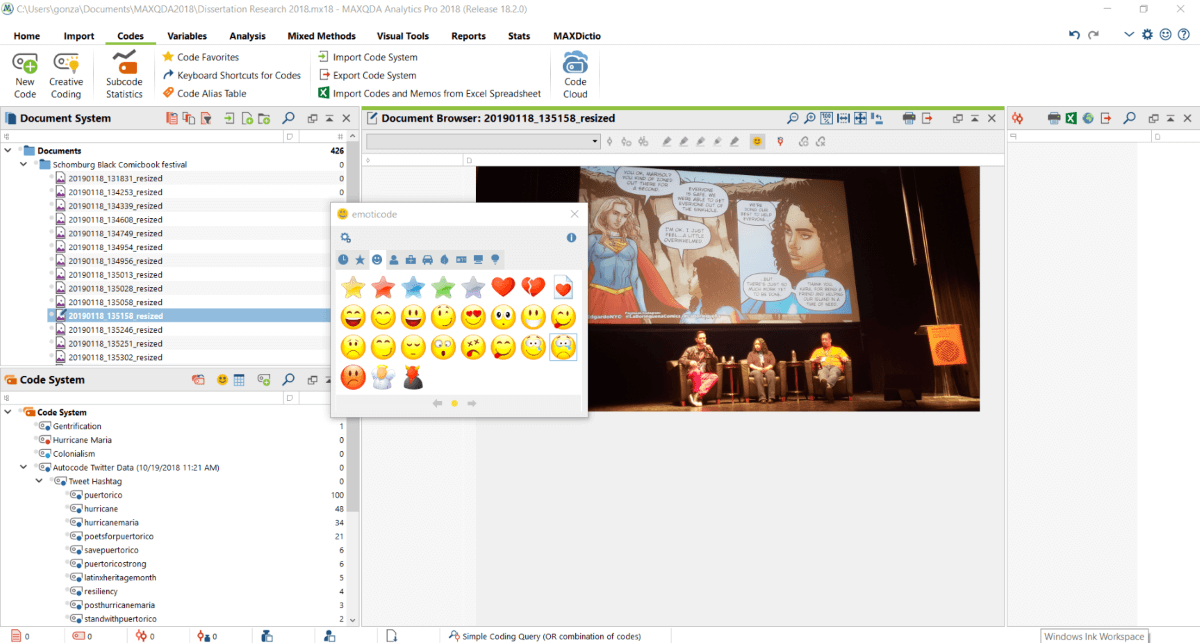
Emoticodes® in MAXQDA
Once I had used emoticodes to code my fieldwork data, I also began to draft notes in order to describe what I was viewing in each of the images. By doing so, it is easier to conduct lexical searches later using MAXQDA. I find that literal description of the images is the best way to analyze the data later.
Once all the images were coded, I wrote down the important themes in my logbook. I really appreciate being able to see this visually in MAXQDA through the Word Cloud visual tool. This visualization allows me to see the most common words being used throughout the project, and these words can become codes later on as well as allow for different forms of visual representation of the research. This is especially useful during conference presentations.
Mapping Word Frequencies with MAXQDA 2018
Using the MAXQDA Web Collector for conducting digital ethnography
As I also engage in digital ethnography, I am able to upload webpages as well into MAXQDA for greater analysis, using MAXQDA’s Web Collector tool. I did this with the Facebook event page for the comic book festival. I was able to also search the hashtags #laborinquena and #ricanstruction for more data.
One thing, I will caution aspiring researchers is that we need to be careful with digital ethnography. It can be endless, so be mindful to set parameters for yourself!
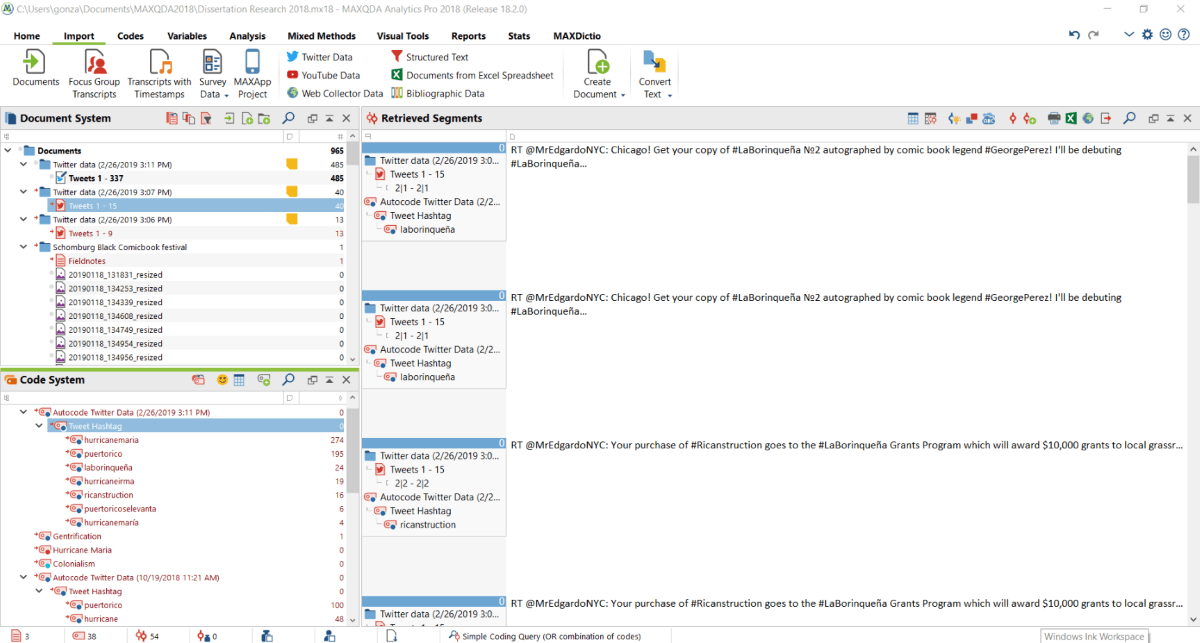
Retrieved Segments of Social Media Data in MAXQDA
To use the Web Collector, you need to install a plugin on your web browser – I use Google Chrome. You simply go on the web page, click on the plugin, and the website is saved into MAXQDA.
The Web Collector offers three modes:
- Entire web pages can be saved. The layout remains optimally maintained.
- Web pages can be saved in a simplified version. The website will be reduced to text and pivotal pictures.
- Selected segments can be saved in order to transfer only a chosen section of a website.
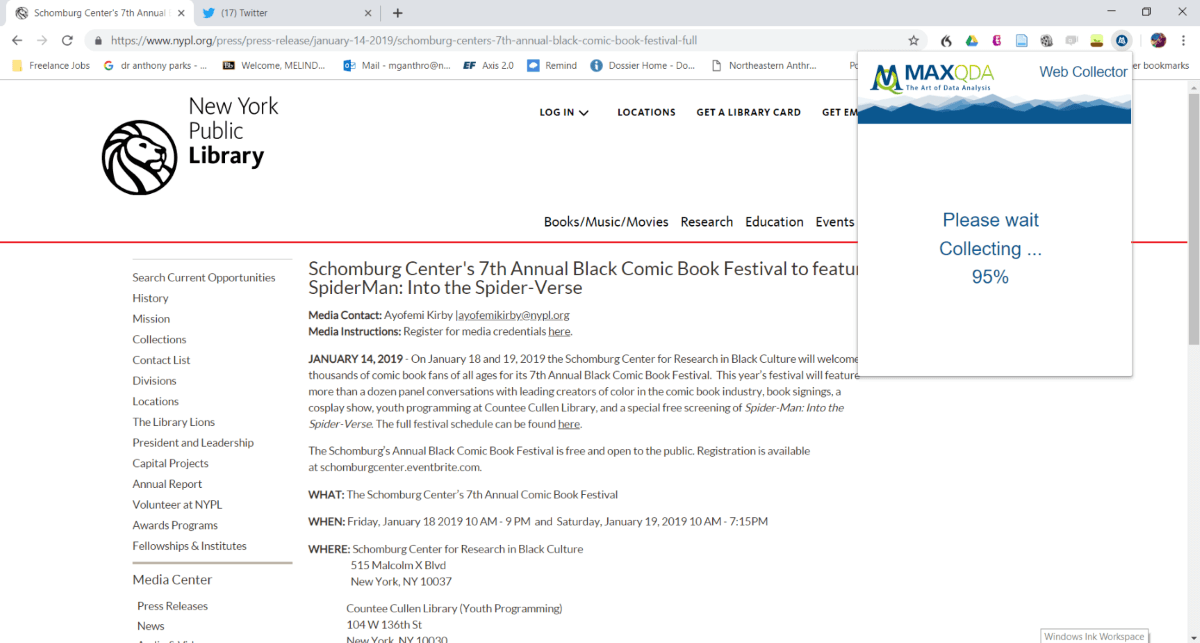
MAXQDA Web Collector
MAXQDA’s Twitter Import
Still, though, I must say that I most appreciate MAXQDA’s integration with Twitter data and how I am quickly and easily able to both import tweets and then autocode them through the click of a couple of buttons!
How to Analyze Twitter Data with MAXQDA
What’s Next
Being able to use these various tools will make writing my dissertation much easier, allowing me to meet my August 2020 graduation deadline. My fieldwork has been fast-moving and, sometimes, it’s hard to keep track of all of the events that I attend and the data that I compile. Being able to use MAXQDA’s software to gather all of this material together is a lifesaver.
In my Final Fieldwork Diary Entry, I will talk about the most recent development in my project, which has focused on volunteering at the New York Disaster Interfaith Service (NYDIS) who were the frontline help for Hurricane Maria evacuees and continue to advocate for evacuees to receive services.
Many Hurricane Maria evacuees from Puerto Rico remain in precarious conditions and in homeless shelters almost a year and a half after the storm. I will talk about the work that NYDIS is doing to confront these challenges and how MAXQDA’s software is helping me document their work.
Editor’s Note
Melinda González is a recipient of MAXQDA’s 2018 #ResearchforChange Grant. Melinda González is a PhD Candidate in Geography and Anthropology on a Cultural Anthropology Track at Louisiana State University, USA. Her research project titled “Rhyming Thru Disaster: Community Organizing in Puerto Rican Poetic Spaces after Hurricane Maria” began in July 2018 in Puerto Rico and New York. Stay tuned for her final fieldwork diary entry coming soon!
Meet the 2018 #ResearchforChange Grant Recipients

